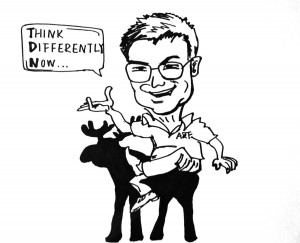Abercrombie indicates market change
Abercrombie & Fitch, the apparel retailer people instantly associated with shirtless and muscular young male models, strong and somewhat nauseous fragrance, dark rooms and nightclub music, is trying to re-image itself after losing its target teen market. When Mike Jeffries took over Abercrombie in 1992, he came up with a business model based on a “sex meets the Ivy League” concept. They started to recruit teens and college students with the “all-American” image to model and work at their stores, created a “young and cool” atmosphere with loud club music and strong perfume/cologne, and perhaps most importantly, they made their clothing elite by selling them at very high prices and in styles that only “fit and sexy” customers can wear. This strategy worked well for a while, but became highly condemned and resented by many American teens. The dislike has been escalated after many disputes over Abercrombie’s “look policy” for employees and CEO Mike Jeffries’ ridiculously arrogant and degrading comments that the “not-so-cool kids” cannot belong in the company’s clothes and that clothing companies that try to include old and fat customers “become totally vanilla.”
Last December, Abercrombie investor and hedge fund Engaged Capital founder Glenn Welling angrily urged Abercrombie & Fitch to replace Jeffries as their CEO due to negative publicity imposed by Jeffries. Eventually, the company decided to separate the CEO and chairman positions, ultimately hiring Arthur Martinez as chairman while maintaining Jeffries as CEO. Abercrombie’s sales and stock prices continued to drop, and the company has been struggling with coming up with plausible strategies to win back their target market.
Finally, in May, Jeffries revealed A&F’s plan to let go of some of its policies and make changes to approach teens today. They decided to change up the atmosphere in stores by taking down blinds on the windows to brighten up the stores and turning the nightclub music down. Also, they took down photos of abs that used to be hung on the walls. The biggest change of all could be that they came up with a “classic fit” t-shirt for men that are looser than the standard muscle t-shirt at Abercrombie, and they added larger sizes to their products.
Abercrombie has also recently changed its brand description. While the old description prided Abercrombie as “the essence of privilege and casual luxury” that was “rooted in East Coast traditions and Ivy League heritage,” the new description calls the company “the next generation of effortless All-American style” associated with “classic campus experiences “ and “moments while traveling.” Also, where it used to be described as “preppy,” “sexy” and “popular,” the new description replaced those words with “laidback,” “creative” and “fun.” The company seems to strive for an image that fits better with today’s more progressive young generation.
This adjustment of A&F’s corporate image then made me wonder: have sex- and privilege-driven business models become too old school, or do teens and college students now look for clothing lines that foster individualism? The answer is probably both. As many could have easily noticed, American teens today prefer more affordable and diverse fashion retailers such as Forever 21, H&M and ZARA, as well as street style-orientated, edgier retailers such as Urban Outfitters and Free People. The major difference between these retailers and A&F is that the former diversifies its products so that everyone can find something that fits his or her personal style. They also constantly come up with new collections that reflect on the newest fashion trends. Besides, these stores have bigger pricing ranges that are more affordable for most customers.
Moreover, in today’s society where economic exclusiveness and discrimination are highly frowned upon and diversity is encouraged, the concept of “cool” has changed drastically. Young people look more for creativity and individuality rather than conformity, and discriminative comments such as those made by Jeffries are not at all tolerable. The American teen fashion industry definitely demonstrates a more open-minded and inclusive young generation. Though Abercrombie is making radical changes to catch up with their target market, they may still not succeed in winning their customers back for a while.
Charlotte Chang is a junior studying Communication.


